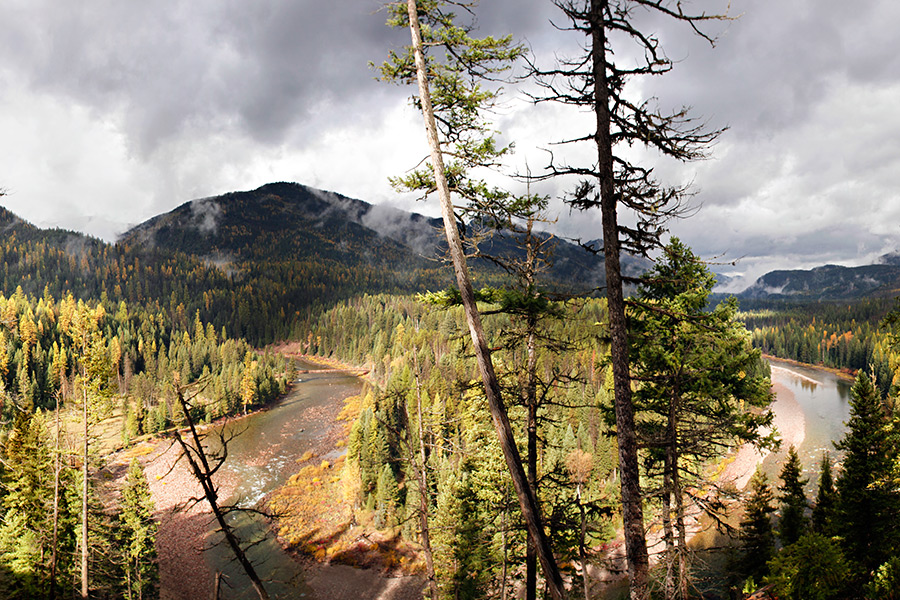A study by the University of Montana’s Bureau of Business and Economic Research found that litigation against U.S. Forest Service timber sales in Northwest Montana is taxing local communities through lost jobs and lower wages.
The study looks beyond the cost of derailed projects on state and federal agencies in the form of plaintiff attorney fees by focusing on a project in which no such fees were paid – the Spotted Bear River Project, which was tangled in lawsuits for years before it was resolved in February.
According to Todd Morgan, BBER director of forest industry research, the economic impacts of the litigation could have exceeded $10 million in jobs, labor income, and federal, state and local taxes, as well as by costing the state’s forest products industry and local communities 130 jobs.
In recent years, litigation has encumbered 40 to 50 percent of the planned timber harvest volume and treatment acres in this corner of the state, Morgan said, while litigation of the Spotted Bear River Project alone involved more than 25 percent of the Flathead National Forest’s fiscal year 2013 timber program.
“These figures are particularly important because litigation of individual cases often exceeds one or two years,” Morgan said of the study, which was completed for the Forest Service and the Montana Forest Products Retention Roundtable. “The relatively simple SBR project we examined spent over 1,000 days in litigation.”
In February, a federal judge in Missoula presiding over the Spotted Bear River Project lawsuit ruled in favor of the Forest Service. The lawsuit centered on a logging project in the South Fork Flathead River corridor, located between the Bob Marshall and Great Bear Wilderness areas.
In the lawsuit, conservation groups contended that the Forest Service failed to consider the cumulative effects on native trout from sediment deposits in the South Fork.
The Forest Service contended that any increase in sediment from the proposed management actions affects only a short segment of the South Fork before it enters Hungry Horse Reservoir, which creates a buffering effect.
Morgan said that while payments of plaintiffs’ attorney fees in such cases which become an interest to a Congress trying to reform federal land management, they “are just the tip of the iceberg when it comes to the cost of litigation of Forest Service projects.”
In comparison, the study showed smaller litigation costs to the federal agencies associated with the Spotted Bear River project. Direct costs to the Forest Service were about $95,000 and about $4,500 for the U.S. Fish and Wildlife Service, not including the costs of the Department of Justice and Office of General Council attorneys defending the Forest Service and FWS.
“When a project is litigated, it is typically the agency’s environmental analysis of the project that is questioned,” Morgan said. “And the agency with its legal counsel must defend the analysis.”
These analyses often stymie other Forest Service projects because highly interrelated issues, such as endangered species habitat, are the basis of many cases, he said. This interconnectedness often stalls other Forest Service projects that are not being litigated directly, according to Morgan.
“The duration of litigation, particularly for cases with a high level of interconnectedness, has a chilling effect on many other projects because of the uncertainty that exists while cases remain in litigation (including appeals to higher courts),” according to the report. “The delays and uncertainty caused by litigation affect local businesses and communities, as well as the Forest Service – even when the agency prevails in court and the timber sales eventually go forward.”
Friends of the Wild Swan and Swan View Coalition filed suit in 2012 in U.S. District Court in Missoula in opposition to the Forest Service’s Spotted Bear River Project, as well as the Soldier Addition II Project on the west side of the South Fork near the Bob Marshall Wilderness Complex.
Keith Hammer, chair and founder of the Swan View Coalition, said the report is misleading, and overlooks the importance that watchdog groups play in ensuring scrutiny of timber projects.
“This report compares apples to oranges to bananas and ends up a fruit smoothy,” Hammer said. “It unsuccessfully tries to pile up the monetary costs of unsuccessful lawsuits with those of successful lawsuits but never once talks about the benefits to the environment from sincere public scrutiny and improved environmental reviews.”
Hammer also noted the correlation of the economic benefits to the region through tourism dollars and its volume of pristine open spaces.
“People don’t visit Montana to view and photograph clear-cuts,” Hammer said. “Maybe BBER should study the relationship between litigation and the conservation of pristine landscapes that foster tourism by protecting the mountains, fish and wildlife that people like to photograph, fish and hunt.”
U.S. Sen. Steve Daines, R-Montana, released a statement immediately after the report was published, calling it “eye-opening” and saying it confirms what he has long suspected.
“Litigation against commonsense timber projects is having far-reaching, damaging impacts on Montana jobs, access to recreation and our environment,” according to the statement. “It is unacceptable that mills in Montana have to go far outside of our state to get logs, largely because 40 to 50 percent of the timber sale volume in Region 1 has been encumbered by litigation in recent years.”
The study is available online at: http://www.bber.umt.edu/pubs/forest/BBERLitigationRpt2015.pdf.
